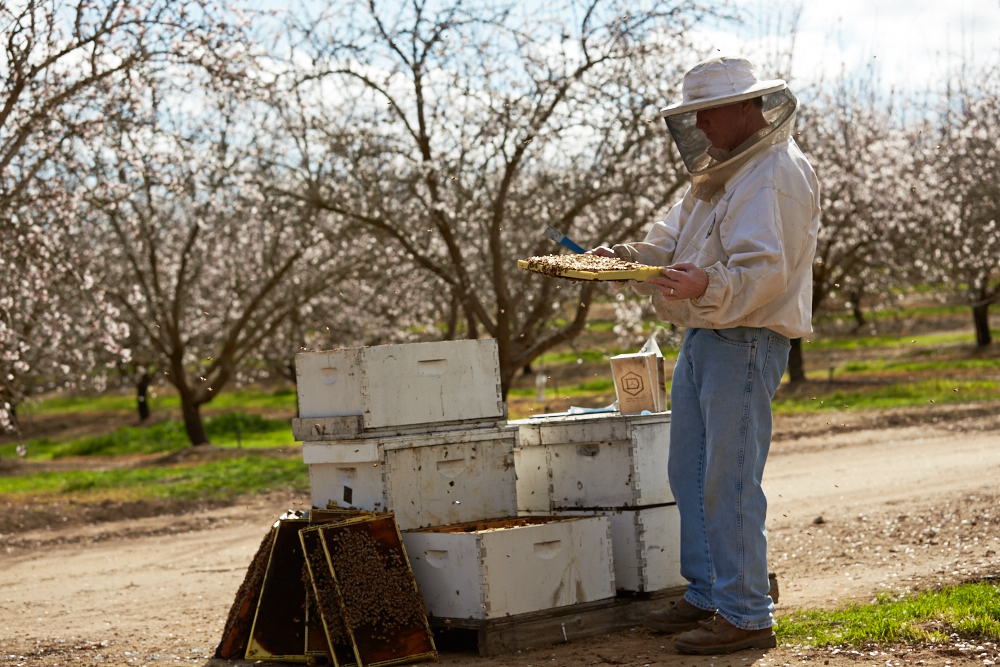At this point in the crop year, growers should ensure they’ve done all they can to prepare for hive arrival. While confirming a bee drop-off area, hive locations and registration are all necessary steps of pollination preparation, another element of setting yourself up for a successful bloom season is assessing the hives once they arrive in the orchard.
 Hive inspections not only help to ensure that growers get what they paid for, but they also help ensure that beekeepers are compensated for additional expenses in providing quality hives. Hives should be inspected for colony strength as well as any other parameters agreed upon by the grower and beekeeper.
Hive inspections not only help to ensure that growers get what they paid for, but they also help ensure that beekeepers are compensated for additional expenses in providing quality hives. Hives should be inspected for colony strength as well as any other parameters agreed upon by the grower and beekeeper.
If you’ve never conducted or issued an inspection before, it is highly recommended that you add this to your pollination protocol. Here’s three quick tips and references to keep in mind as you consider your process for hive inspections:
- Hives should be inspected as soon as they arrive in the orchard. An inspection should take place by either the beekeeper or an objective third-party apiary inspector. Growers should plan to observe the inspection.
- It is best to let the hives acclimate to the orchard landscape before conducting the inspection.
- If the beekeeper is not conducting the inspection, growers should still notify the beekeeper whose hives are being inspected so they can assist in handling the hives.
- A number of new companies offer sensor technologies that allow the assessment of hive strength without opening up the hives for inspection. While growers and beekeepers are just gaining experience with these new technologies, though, the Almond Board continues to recommend a professional hive inspection.
- Guidelines for how to conduct a hive inspection may be found in the learning course “Honey Bees and Colony Strength Evaluation,” which can be accessed at Class.UCANR.edu in the “Agriculture” folder. This online education and training course provides protocols for assessing the strength of honey bees and colonies, and can also help growers become better informed when renting hives from beekeepers and hiring apiary inspectors. The course covers basic bee biology and colony organization, different inspection procedures and standards, and how to recognize some parasites, diseases and other potential problems.
- Growers should further monitor colony strength by walking orchards daily during bee flight hours to observe activity levels. In addition, growers should record hives that appear weak (i.e., relatively few bees coming and going at the hive entrance) or inactive, and then report those hives to the beekeeper.
Growers, applicators and other pollination stakeholders are invited to attend an upcoming California Almond Sustainability Program (CASP) “In the Orchard” workshop focused on pollination and cover crops. Attendees will learn about the latest research and best practices in honey bee health, the tools in CASP to help them assess their pollination practices and how maintaining honey bee health will help the industry achieve its Almond Orchard 2025 Goals. Each workshop will also feature a local grower who will share his or her experience planting and maintaining cover crops on their operations.
Workshops will be held Jan. 16 in Sutter, Jan. 22 in Ceres and Jan. 23 in Buttonwillow. Visit Almonds.com/Events to learn more and to RSVP.
For more tips on how to maintain honey bee health before, during and after bloom, growers and other pollination stakeholders are encouraged to reference the Almond Board of California’s Honey Bee Best Management Practices, found online at Almonds.com/Pollination.


